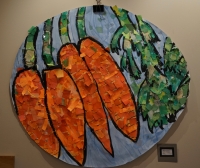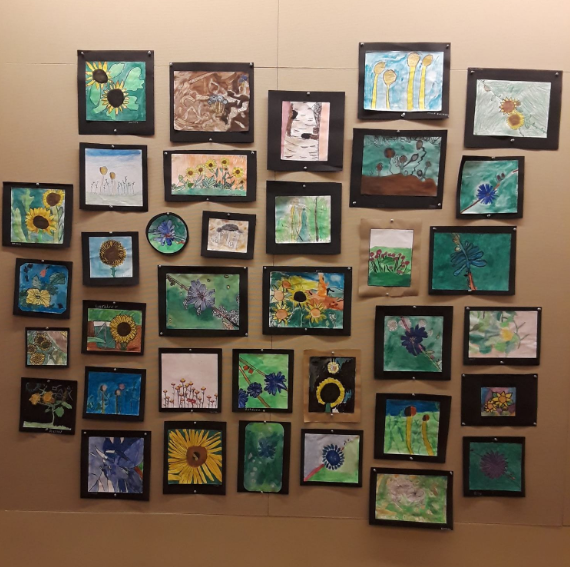Check out the video below for a virtual “tour” of our the art gallery.
Special thanks to Christina Ramirez for providing photos of ICS students engaged in their artistic process!
I don’t know about you, but it’s hard not to feel hopeful and full of life after looking at all those brilliant and lovely pieces—don’t you think? Make sure to take a look at the photos in the gallery below so you can see all the pieces up close. Remember, the smaller rectangular paintings are individual pieces by the 4th graders and the big circular collages are the collaborative work of kindergarteners at Indian Community School and Milwaukee Jewish Day School. So amazing, right!?
Click on to the below image to enjoy the gallery
Many of the pieces in this show are for sale! Sales support Indian Community School students, as well as the Urban Ecology Center!
Contact Glenna at This email address is being protected from spambots. You need JavaScript enabled to view it. if you are interested in purchasing a particular piece.
All this beautiful and detailed work also makes me want to look more closely at some of the nature near my home, and maybe even try out some artistic projects of my own! Below are some ideas for discussion questions or activities with your family in case you’re feeling inspired too!
Discussion Questions:
- Which piece did you like the best? Why?
- What experiences in your own life did the art work remind you of?
- What interests you most about these works of art? What do you wonder about?
- What questions would you have for the artists who created the piece?
- Pretend you are inside one of the pieces. What does it feel like?
- In the artist statement, students talked about thinking of food as medicine. What does that mean to you?
- Think of a natural place that is important to you. Who takes care of that land? Who do you think has taken care of that land in the past? What could you do to help take care of that land?
Activities:
- Gratitude and Land Acknowledgement: Spend some time reflecting on this question from the discussion prompts above: Who has taken care of the land where you live, before you lived there? Take a look at this map to learn more about which indigenous people have called this place home and cared for the land. On a piece of paper or in a journal, write a note of thanks to all those have cared for the land before you.
- Do a scientific drawing: Find a bud or an emerging plant in your neighborhood. Study it up close. Use a hand lens to examine it if you have one or just get as close to the plant as possible—really look at the texture, color, and all the details! Then, use a piece of paper and a pencil to draw your plant in as much detail as possible. Add colors if you can!
- Take a photo walk: If you have access to a camera, go for a nature walk in your yard, neighborhood, or nearby park, taking pictures of cool natural items you find. Remember to change perspective often, looking at things from above, below, and beside to get the most interesting angle! For an extra bonus, show the pictures to a family member and see if they can match them with the items along your walking route!
- Find a sit spot: Take a look at this video by UEC Educator Kirsten Maier on a fun way to make scientific observations right in your own backyard!
- Memory test: Collect 10-20 of the same “kind” of natural item (so 10 rocks, or 10 sticks, or 10 leaves, etc). Choose one of the items and study it up close for 1 minute. Use your sense of sight, touch, and even smell if you want to! Then, put your item back in with the rest of the items, mix them up, and see if you can find yours. What lets you know for sure that one is yours?
- Partner Game: With a partner, collect a bunch of different natural items (sticks, rocks, leaves, flower petals, feathers, etc). Have each partner select one of the items to study WITHOUT showing the other partners which one it is. While studying your item, write down as many words as you can think of to describe it (words like “smooth,” “grey,” “bumpy,” or “slippery”). Once you and your partners have completed your lists, put your natural items back into the whole group of items (remember: don’t let your partner see which one it is!). Then, take turns reading one word from your list at a time while your partner guesses which item you were describing!
- Colors of Nature: Find colorful leaves, plants, sticks, or rocks in your yard, park, or neighborhood. Using a piece of paper, experiment with which of the items you can “draw” or “paint” with! Which one leaves the darkest mark? The most colorful?
- Painting Nature: Find a color out in nature that you really love (could be a flower, the bark of the tree, the sky). Either take a sample of the color (if it’s something like a leaf or a flower petal), or take a picture, and bring it inside. Experiment with different combinations of paint colors until you get a color that matches the color you found in nature!
Thanks for bringing the UEC into your living room! We can’t wait until we get to be together again, but until then, come back to this page as often as you’d like to enjoy the beautiful art from Indian Community School students. And if you try out any of these activities be sure to tag us on social media with the #uecinmybackyard.






